ohio
 On September 26, 1774, a man named John Chapman, who is my 6th cousin 6 times removed, was born in Leominster, Massachusetts. John was the second child, after his sister Elizabeth, of Nathaniel and Elizabeth Chapman. While Nathaniel was in military service, his wife died on July 18, 1776, shortly after giving birth to a second son, Nathaniel. The baby died about two weeks after his mother. Nathaniel Chapman ended his military service and returned home in 1780 to Longmeadow, Massachusetts. In the summer of 1780 he married Lucy Cooley of Longmeadow, Massachusetts, and they had 10 children. So in the end, John Chapman came from a large family. You might wonder what all this has to do with anything, and I suppose you would be justified in asking, but I think when you hear John Chapman’s nickname, you might know who I am talking about. For most of his life, John Chapman was called, Johnny Appleseed. Most people will remember him from the history books, as an American pioneer nurseryman who introduced apple trees to large parts of Pennsylvania, Ontario, Ohio, Indiana, and Illinois, as well as the northern counties of present-day West Virginia. He became an American legend while he was still alive, due to his kind, generous ways, his leadership in conservation, and the symbolic importance he attributed to apples. These days plant nurseries are often named after Johnny Appleseed, including on in my city of Casper, Wyoming.
On September 26, 1774, a man named John Chapman, who is my 6th cousin 6 times removed, was born in Leominster, Massachusetts. John was the second child, after his sister Elizabeth, of Nathaniel and Elizabeth Chapman. While Nathaniel was in military service, his wife died on July 18, 1776, shortly after giving birth to a second son, Nathaniel. The baby died about two weeks after his mother. Nathaniel Chapman ended his military service and returned home in 1780 to Longmeadow, Massachusetts. In the summer of 1780 he married Lucy Cooley of Longmeadow, Massachusetts, and they had 10 children. So in the end, John Chapman came from a large family. You might wonder what all this has to do with anything, and I suppose you would be justified in asking, but I think when you hear John Chapman’s nickname, you might know who I am talking about. For most of his life, John Chapman was called, Johnny Appleseed. Most people will remember him from the history books, as an American pioneer nurseryman who introduced apple trees to large parts of Pennsylvania, Ontario, Ohio, Indiana, and Illinois, as well as the northern counties of present-day West Virginia. He became an American legend while he was still alive, due to his kind, generous ways, his leadership in conservation, and the symbolic importance he attributed to apples. These days plant nurseries are often named after Johnny Appleseed, including on in my city of Casper, Wyoming.
According to some accounts, an 18 year old John persuaded his 11 year old half-brother Nathaniel to go west with him in 1792. The boys lived a nomadic life until their father brought his large family west in 1805 and met 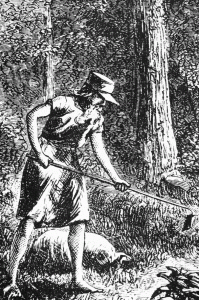 up with them in Ohio. Nathaniel decided to stay and help their father farm the land. A short time later, John began his apprenticeship as an orchardist under a Mr. Crawford, who had apple orchards, and so began his life’s journey of planting apple trees. There are stories of Johnny Appleseed practicing his nurseryman craft in the area of Wilkes-Barre, Pennsylvania, and of picking seeds from the pomace at Potomac cider mills in the late 1790s. Another story has Chapman living in Pittsburgh on Grant’s Hill in 1794 at the time of the Whiskey Rebellion.
up with them in Ohio. Nathaniel decided to stay and help their father farm the land. A short time later, John began his apprenticeship as an orchardist under a Mr. Crawford, who had apple orchards, and so began his life’s journey of planting apple trees. There are stories of Johnny Appleseed practicing his nurseryman craft in the area of Wilkes-Barre, Pennsylvania, and of picking seeds from the pomace at Potomac cider mills in the late 1790s. Another story has Chapman living in Pittsburgh on Grant’s Hill in 1794 at the time of the Whiskey Rebellion.
The most popular image is of Johnny Appleseed spreading apple seeds randomly everywhere he went. In reality, he planted nurseries rather than orchards, and then built fences around them to protect them from livestock. Then he left the nurseries in the care of a neighbor who sold trees on shares, and returned every year or two to tend the nursery. His first nursery was planted on the bank of Brokenstraw Creek, south of Warren, Pennsylvania. Next, he seems to have moved to Venango County along the shore of French Creek, but many of his nurseries were in the Mohican area of north-central Ohio. This area included the towns of Mansfield, Lisbon, Lucas, Perrysville, and Loudonville.
Johnny Appleseed was a bit of a missionary too. He would tell stories to children and spread The New Church gospel to the adults, receiving a floor to sleep on for the night, and sometimes supper, in return. “We can hear him read now, just as he did that summer day, when we were busy quilting upstairs, and he lay near the door, 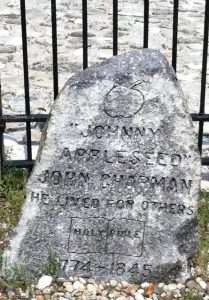 his voice rising denunciatory and thrillin—strong and loud as the roar of wind and waves, then soft and soothing as the balmy airs that quivered the morning-glory leaves about his gray beard. His was a strange eloquence at times, and he was undoubtedly a man of genius,” reported a lady who knew him in his later years. He made several trips back east, both to visit his sister and to replenish his supply of Swedenborgian literature. Swedenborgian was also known as Swedenborgianism and the General Church of the New Jerusalem. Several historically related Christian denominations were developed as a new religious movement, by the writings of Emanuel Swedenborg. Johnny preached the gospel as he traveled, and converted many Native Americans. The Native Americans regarded him as someone who had been touched by the Great Spirit, and even hostile tribes left him strictly alone. Johnny passed away about 1845, with several dates being given. I guess no one really knew the date for sure. I think my cousin might have been a very interesting man.
his voice rising denunciatory and thrillin—strong and loud as the roar of wind and waves, then soft and soothing as the balmy airs that quivered the morning-glory leaves about his gray beard. His was a strange eloquence at times, and he was undoubtedly a man of genius,” reported a lady who knew him in his later years. He made several trips back east, both to visit his sister and to replenish his supply of Swedenborgian literature. Swedenborgian was also known as Swedenborgianism and the General Church of the New Jerusalem. Several historically related Christian denominations were developed as a new religious movement, by the writings of Emanuel Swedenborg. Johnny preached the gospel as he traveled, and converted many Native Americans. The Native Americans regarded him as someone who had been touched by the Great Spirit, and even hostile tribes left him strictly alone. Johnny passed away about 1845, with several dates being given. I guess no one really knew the date for sure. I think my cousin might have been a very interesting man.
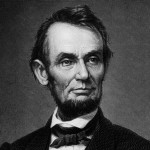 Hot air balloons have been around for a long time, and there have been multiple uses for them. Hot air balloons have been used for everything from travel, recreation, escape, war, and even spying. It was the latter reason that brought President Abraham Lincoln to a field outside Washington DC on October 4, 1861. Those were tumultuous years, with the Civil War in full swing, and both the Confederate and the Union armies were experimenting with the idea of using hot air balloons to gather military intelligence. It was probably a good idea, but there was enough danger involved with this idea, that it proved to be impractical in most situations.
Hot air balloons have been around for a long time, and there have been multiple uses for them. Hot air balloons have been used for everything from travel, recreation, escape, war, and even spying. It was the latter reason that brought President Abraham Lincoln to a field outside Washington DC on October 4, 1861. Those were tumultuous years, with the Civil War in full swing, and both the Confederate and the Union armies were experimenting with the idea of using hot air balloons to gather military intelligence. It was probably a good idea, but there was enough danger involved with this idea, that it proved to be impractical in most situations.
I don’t think most people who were presented with the idea of using hot air balloons in a war situation, were very sold on it. Several firms had been talking to the War Department about balloons, but Thaddeus SC Lowe, who had been working with hydrogen balloons for several 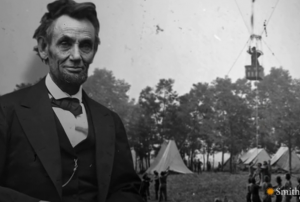 years, and was convinced that they could be a useful tool for collecting intelligence, was the primary figure in that quest. He had conducted trials in April 1861 near Cincinnati, Ohio, with the support of the Smithsonian Institution. On April 19, 1861, he took flight for a trip that would take him to Unionville, South Carolina, where he was immediately jailed by the Confederates, who were convinced that he was a Union spy.
years, and was convinced that they could be a useful tool for collecting intelligence, was the primary figure in that quest. He had conducted trials in April 1861 near Cincinnati, Ohio, with the support of the Smithsonian Institution. On April 19, 1861, he took flight for a trip that would take him to Unionville, South Carolina, where he was immediately jailed by the Confederates, who were convinced that he was a Union spy.
In the end, Lowe had it right. The hot air balloon could be instrumental in winning a war. He became the head of the Union’s Balloon Corpsin 1861 and served effectively during the Peninsular campaign of 1862. With the views provided from his balloon, Lowe discovered that the Confederates had evacuated Yorktown, Virginia, and 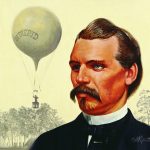 he provided important intelligence during the Battle of Fair Oaks, Virginia. He had a good working relationship with George McClellan, commander of the Army of the Potomac, but had difficulties with McClellan’s successors. Generals Ambrose Burnside and Joseph Hooker were sadly not convinced that balloon observations provided accurate information. I guess they just didn’t have the same vision as Lowe had. Lowe became increasingly frustrated with the army, particularly after his pay was slashed in 1863. Feeling that army commanders did not take his service seriously, Lowe resigned in the spring of 1863. The Balloon Corps was disbanded in August of that year. Lowe later became involved in building a railway in California. He died there in 1913 at age 80.
he provided important intelligence during the Battle of Fair Oaks, Virginia. He had a good working relationship with George McClellan, commander of the Army of the Potomac, but had difficulties with McClellan’s successors. Generals Ambrose Burnside and Joseph Hooker were sadly not convinced that balloon observations provided accurate information. I guess they just didn’t have the same vision as Lowe had. Lowe became increasingly frustrated with the army, particularly after his pay was slashed in 1863. Feeling that army commanders did not take his service seriously, Lowe resigned in the spring of 1863. The Balloon Corps was disbanded in August of that year. Lowe later became involved in building a railway in California. He died there in 1913 at age 80.
 My niece, Dustie Masterson reminds me a little bit of Ruth in the Bible. Her family is from Ohio, and for a time, she and my nephew, Rob moved back there, but after a short time, they returned to Wyoming. I know that she loves her family in Ohio, but like Ruth, she has chosen to live where his family lives. She has chosen to embrace her Masterson/Spencer side of the family, and we are all pleased. Over the past few years, she has been such a help to her mother-in-law, my sister, Cheryl Masterson, and her grandma, my mom, Collene Spencer. She would often go to the store for them, as well as running other errands.
My niece, Dustie Masterson reminds me a little bit of Ruth in the Bible. Her family is from Ohio, and for a time, she and my nephew, Rob moved back there, but after a short time, they returned to Wyoming. I know that she loves her family in Ohio, but like Ruth, she has chosen to live where his family lives. She has chosen to embrace her Masterson/Spencer side of the family, and we are all pleased. Over the past few years, she has been such a help to her mother-in-law, my sister, Cheryl Masterson, and her grandma, my mom, Collene Spencer. She would often go to the store for them, as well as running other errands.
It isn’t all about what Dustie has done for Cheryl either, but also about how she feels about Cheryl. She considers Cheryl to be a second mom. It isn’t that she doesn’t love her own mom, but she also shares a closeness with her mother-in-law. And it is really more than a closeness. You don’t help someone 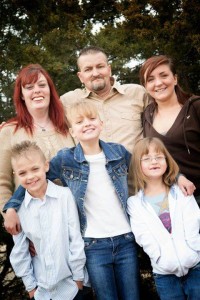 through some of the worst moments of their life and no feel very close to them. You don’t share the hardest situations, and not develop a closeness from it. I have seen that in several family members over the years.
through some of the worst moments of their life and no feel very close to them. You don’t share the hardest situations, and not develop a closeness from it. I have seen that in several family members over the years.
There are many things about Dustie that are obviously very different from the person Ruth was, but when I was deciding what to write about her for her birthday, a picture of Ruth and Naomi came to mind. I thought, “That is a lot like Dustie and Cheryl.” Dustie is Cheryl’s only daughter-in-law, and often that person feels a little alienated, but that has not been the case between these two. Dustie comes to Cheryl for advise, and even when she just needs a hug. They are as close as a mother and daughter could be. I think that Cheryl considers Dustie to be her daughter, not daughter-in-law.
Dustie has been such a soulmate for my nephew, Rob. They have been in love since they first met. She has been a great step-mom to Rob’s daughter, Christina, and the two of them have three wonderful children together. Theirs is a life full of blessings, and they are counting those blessings every day. Theirs is a busy life,  with activities that the kids are into, but that is a blessing too, because as we all know, children grow up far to quickly, and then they are out on their own.
with activities that the kids are into, but that is a blessing too, because as we all know, children grow up far to quickly, and then they are out on their own.
Dustie has worked at Albertson’s now for a number of years. She seems to love her job, and they like her. She is a fresh cut specialist and supervisor, and really enjoys what she is doing. Of course, her first priority is her family. She is so proud of all the things her children have accomplished, and they, in turn, are very proud of her. Dustie is a sweetheart, and a lot of fun to be around. Her smile lights up a room. Today is Dustie’s birthday. Happy birthday Dustie!! Have a great day!! We love you!!

